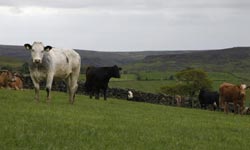Beef and sheep production – the challenge of balancing productivity with natural resource use

Cattle in England<br>(© Katja Seifert, Thünen Institute) <br>
Can beef and sheep production keep pace with increasing demand and reflect growing concerns about natural resource use? This was one of the central questions addressed in the agri benchmark Beef and Sheep Conference 2013 hosted by the English Beef and Lamb Executive EBLEX in York England from June 13-19.
Some 29 countries participate in the global network, including new members Ireland, Namibia and Uruguay. The week-long event consisted of an internal workshop and a public Global Forum on the final day.
Beef production: the world is getting closer
Global beef production continues to face major changes. Growing demand drives beef prices up but feed and land prices keep pace and government payments linked (coupled) to production have disappeared in almost all countries and were only partially replaced by more targeted support, for example for environmental services. As a result, the margins of typical farms analysed by agri benchmark have remained unchanged or decreased. “Over the last ten years, we have seen the levels of prices and costs between countries narrowing continuously”, said Claus Deblitz, senior scientist at the German Thünen Institute and coordinator of the agri benchmark Beef Network, “A number of countries in Asia, the Middle East and North Africa, as well as Russia have joined the group of high cost and high price countries with implications for competitiveness and global trade flows.” In this context, with land values seven times as high as 10 years ago, Uruguay provides yet another example of dramatic land use changes. Similar to Argentina, the drivers here were the expansion of soybean, corn and wheat production which led to a dislocation of beef and sheep production to more marginal areas.
Growth issues in sheep production
In his overview on global trends in sheep production, Peter Weeks, representing Meat and Livestock Australia pointed out that “sheep prices continue to rise as supply struggles to meet demand”. There are various limitations to the production of sheep meat: competition for land, degradation of grasslands, rising feed costs, labour shortage and poor prices for the by-product wool. However, global sheep meat consumption is rising, and demand is expected to further increase in the future. This trend is particularly evident in China. China’s share in global sheep production is 26 % and China has dominated sheep production growth in the last 10 years with profitable sheep farming due to the high sheep meat prices. In arid areas such as Inner Mongolia but also in Northern African countries, sheep production often leads to overgrazing, the degradation of grasslands and subsequent low productivity levels.
The need to be more productive …
With competition from crop farming and other livestock industries, beef and sheep production must become more productive in terms of land, labour and animal performance if the present production levels are to be maintained or even increased. The two main pathways are a) the increase of productivity in pasture systems (both cow-calf and finishing) and b) the shift of finishing cattle from pasture to grain finishing in feedlots for the last few months of the finishing period. Adjusting stocking rates to carrying capacity and introducing related management practices in vulnerable areas can provide an opportunity to increase both individual animal performance and land productivity. Recent production increases have in fact mainly been driven by productivity increases, often accompanied by decreasing cattle and sheep inventories. Sheep production in New Zealand provides an example where weight sold per ewe increased by almost 80 percent in the last 20 years, driven by higher lambing percentages and higher slaughter lamb weights.
Carol Davis, senior analyst with EBLEX, concluded that “the reduction of the difference between the top and bottom 30 percent performers constitutes a huge potential, even for so-called 'developed' countries.” The participants agreed that achieving this goal is not only a matter of technology and research but also requires access to education and knowledge by producers. To address and analyse the issues surrounding productivity growth and natural resource use in a systematic way, agri benchmark has been elected to chair the focus area group 'Closing the efficiency gap' within the FAO-led multi-stakeholder initiative Global Agenda of Action.
… and the need to measure
Measuring animal performance starts on farm (“buy a weigher”) and can be taken to global level. Assessing the status quo situation and possible improvements in production and their economic implications in a comparable way is key to the process of informing decision makers in agriculture, agribusiness and policy.
agri benchmark is a global, non-profit network of agricultural economists, advisors, producers and specialists in key sectors of agricultural and horticultural value chains. We analyse production systems, their economics, drivers and perspectives on a permanent basis, generating annual updates of data and results and providing a unique data set of typical agricultural farms and production systems. The data can be used for farm comparisons, policy and farm strategy analysis. agri benchmark was initialised by the German Thünen Institute and the Deutsche Landwirtschafts-Gesellschaft (DLG). More information and publications: http://www.agribenchmark.org/
Contact:
Dr. Claus Deblitz
Thünen Institute of Farm Economics, Braunschweig, Germany
Tel.: +49 (0) 531 596-5155, E-mail: claus.deblitz@ti.bund.de
Media Contact
All latest news from the category: Agricultural and Forestry Science
Newest articles

Compact LCOS Microdisplay with Fast CMOS Backplane
…for High-Speed Light Modulation. Researchers from the Fraunhofer Institute for Photonic Microsystems IPMS, in collaboration with HOLOEYE Photonics AG, have developed a compact LCOS microdisplay with high refresh rates that…

New perspectives for material detection
CRC MARIE enters third funding period: A major success for terahertz research: Scientists at the University of Duisburg-Essen and the Ruhr University Bochum have been researching mobile material detection since…

CD Laboratory at TU Graz Researches New Semiconductor Materials
Using energy- and resource-saving methods, a research team at the Institute of Inorganic Chemistry at TU Graz aims to produce high-quality doped silicon layers for the electronics and solar industries….



